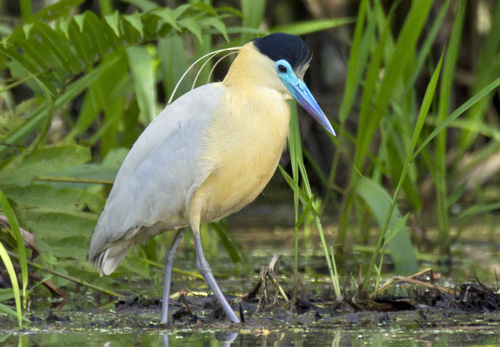
An elegant Capped Heron stalks the shady lakeshore by our cabins at Sani Lodge. Photo: Steve N.G. Howell
The Amazonian lowlands of eastern Ecuador harbor one of the most diverse avian assemblages in the world, comparable to parts of eastern and southeastern Peru in both richness and beauty. Sani Lodge, two and a half hours by boat down the Napo River from the end of the road at the Amazonian town of Coca, sits on an oxbow lake in the heart of the Amazon rainforest and offers excellent access to the region’s extraordinary diversity. Over 500 species of birds are known from this single locality, including four species of macaw, 10 puffbirds, seven toucans, and more than 40 species of antbirds. From the lodge it is possible to see classic Amazonian species like White-throated Toucan, Red-bellied Macaw, Masked Crimson Tanager, and Black-fronted Nunbird, all common, and with only a short canoe ride the rare and local become possible, including species such as Orange-crowned Manakin, White-lored Antpitta, Orange-eyed Flycatcher, and the extremely local Cocha Antshrike. A sturdy steel 150-foot high canopy tower, easily accessible by stairs, supplies a brilliant dimension to Amazonian birding: the ability to observe many canopy species up close, such as White-browed Purpletuft and Yellow-billed Nunbird, along with a wide array of canopy tanagers and flycatchers.
Owned, managed, and operated by the indigenous Kichwa community, Sani Lodge is a comfortable place to base an Amazon birding tour, with its wonderful meals, private cabins, and excellent service. Although most trips to Amazonian lodges are only a few days, our longer stay permits a fuller exploration of the area’s extraordinary biodiversity.
This tour can be taken in conjunction with our June Ecuador: Mindo & the NW Andes tour.
Day 1: The tour begins this evening in Puembo, a colonial suburb of Quito. Night in Puembo.
Steve Howell was an excellent leader, teacher and birder, always thoughtful and thorough in communicating with us. Steve taught us group protocols which made sure everyone was able to have turns in the front of the line and so all could take advantage of the leaders. Steve is also an excellent bird finder and helped us see many wonderful birds and mammals. He has a great combination of qualities between his passion/love for, as well as scientific understanding of the natural world. We also benefited greatly from our local guide, Carlos Gualinga, who as native of the Sani Community had a knowledge of the Amazon jungle that only someone raised there could have. Carlos’s ability to perceive and find birds in the hidden canopy hovered on the supernatural. Between Steve and Carlos we had the best of Western and Indigenous minds working together in harmony.
Karen Nani Apana, August 2016
Day 2: We’ll fly this morning over the Andes to the Amazonian town of Coca and board our motor boat for the two-and-a-half hour ride down the Napo River to Sani Lodge. As the lodge itself is located on an oxbow lake (or cocha), not the main river, we’ll walk for about 15 minutes on a boardwalk trail to the lake then transfer to small dugout canoes for the tranquil 15-minute paddle to our accommodations for the next seven nights. After a welcome drink, we may make our first of many excursions out onto Challuacocha, the lake that is not only our “highway” to various parts of the nearby jungle, but also a prime birding spot of its own. Night at Sani Lodge.
Days 3-8: Six full days at Sani will give us ample time to explore the many different habitats accessible from the lodge. One of the most appealing aspects of our stay at Sani will be the leisurely canoe rides around this serene lake. We’ll be watched by the prehistoric-looking Hoatzins as we’re paddled in search of species found only in flooded forest and lake edges, including Capped Heron, White-chinned Jacamar, Dot-backed and Silvered Antbirds, Cinnamon Attila, Black-capped Donacobius, Buff-breasted Wren and the striking Masked Crimson Tanager. The boardwalk between the Napo River and Challuacocha traverses excellent semi-flooded forest, and we’ll look for the stunning Cream-colored Woodpecker, as well as Plumbeous and White-shouldered Antbirds and Cocha Antshrike, a species that until 1990 was known to science from only a single female specimen.
The trail system of Sani Lodge will enable us to explore superb várzea (seasonally flooded) rainforest. The list of species found in this vanishing habitat is seemingly endless, and we’ll spend time walking through the forest in a quest for mixed-species flocks of woodcreepers, antbirds, ovenbirds, flycatchers, and tanagers. Among the more beautiful birds that we’ll search for in the upland (terra firme) rainforest are Purplish Jacamar, Golden-collared Toucanet, Collared Puffbird, Scale-breasted and Ringed Woodpeckers, Fulvous Antshrike, Chestnut-belted Gnateater, Wire-tailed and Golden-headed Manakins, and Fulvous Shrike-Tanager. On the nightbird front, we’ll look for Crested and Spectacled Owls and Tawny-bellied and Tropical Screech-Owls, as well as Great, Common, and Long-tailed Potoos and Short-tailed Nighthawk.
One of our regular birding destinations during our stay will be the canopy tower. With a sturdy staircase and a large wooden platform that wraps around a gargantuan tree, the tower offers us access to one of the least-known habitats in the tropical rainforest—the canopy. Some of the many possibilities from the tower are Blue-throated Piping-Guan, Great Potoo, Blue-and-yellow and Scarlet Macaws, Spangled and Plum-throated Cotingas, Yellow-browed Tody-Flycatcher, Many-banded and Ivory-billed Aracaris, and Paradise, Green-and-gold, Turquoise, Opal-rumped, and Yellow-bellied Tanagers… and perhaps even a Harpy or Crested Eagle. Each visit to the tower brings something unexpected.
A highlight of any trip to Sani is a visit to one or more parrot clay licks. Hundreds of parrots come early in the morning to replenish their mineral supply by licking and pecking at exposed rocky areas. If we are fortunate, we may see as many as four or five species using the lick at the same time, including hundreds of White-eyed and Dusky-headed Parakeets with smaller numbers of Mealy, Yellow-crowned, and Blue-headed Parrots.
Yasuni National Park, on the south bank of the Rio Napo, will be another of our destinations. We’ll spend at least one day exploring the trails that wind into the terra firme forest, which supports a somewhat different assortment of species from the north bank of the Napo. We might even be lucky enough to find an army ant swarm, one of the great rainforest birding spectacles, with its attendant bird species. Some of the specialties in Yasuni include Lunulated, Hairy-crested, White-plumed, and Banded Antbirds, Yasuni Antwren, and Blue-backed Manakin, along with a few species of monkey not found on the north bank, including the endearing Golden-mantled Tamarin.
An afternoon or morning will be devoted to visiting islands in the Napo River, where a yet another set of species can be found, some of which are so specialized that they have never been recorded on the ‘mainland’. We’ll look particularly for White-bellied Spinetail, Castelnau’s Antshrike, Black-and-white Antbird, River Tyrannulet, Olive-spotted Hummingbird, and Orange-headed Tanager. We may also see see Collared Plover, Large-billed and Yellow-billed Terns, Ladder-tailed Nightjar, and perhaps some migrant shorebirds such as Greater Yellowlegs and Pectoral Sandpiper.
In addition to birds are all the other things that make the Amazonian rainforest one of the most diverse environments on the planet. While we’d be very lucky to see a cat (Jaguar and Ocelot are perhaps the ‘least unlikely’ species we’d encounter), we should see several species of monkeys, perhaps Giant River Otters or a sloth, maybe even a tapir, and who knows what else? The amazing butterflies, frogs, and other critters will all be part of our remarkable experience. Nights at Sani Lodge.
Day 9: We may have a little time to bird around the lodge in the morning before we depart for the boat ride back to Coca and flight on to Quito. Most international flights depart late at night, and we’ll reach Quito in good time for connections. We’ll arrange day rooms at a hotel in order to shower, repack, rest a little, and perhaps savor a beer with our last birdlist before reluctantly leaving this amazing country.
Updated: 07 June 2023
Prices
- 2025 Price Not Yet Available
- (2024 Tour Price$4,990)
Notes

Questions? Tour Manager: Greg Greene. Call 1-866-547-9868 (US or Canada) or (01) 520-320-9868 or click here to email.
* Tour invoices paid by check carry a 4% discount. Details here.
Maximum group size seven with one leader.
